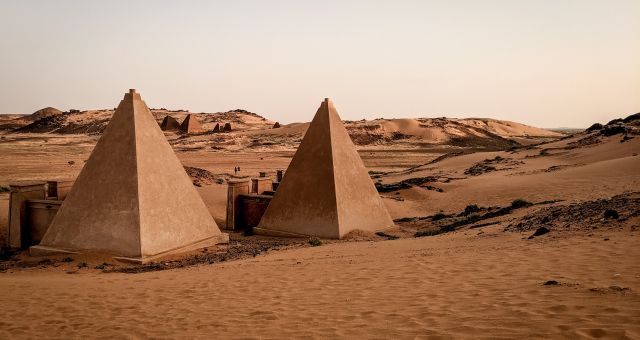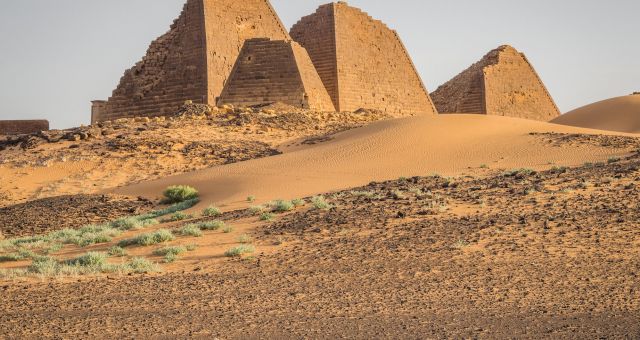Many of those traveling to Sudan make seeing Meroe pyramids and other ancient Sudanese ruins a priority. For good reason. Sudan’s ancient treasures is unique and worthy of a visit. However, I’d recommend that visitors to Sudan not to miss Kassala in the eastern part of the country, near the Eritrean border. It ended up being my favorite place I visited during my independent travel to Sudan. But then again, if you know me it won’t be a surprise. As soon as I saw a picture of Taka Mountains, I knew I had to visit Kassala.
Taka Mountain range in Sudan
I almost didn’t go. Someone I was in contact with told me that her NGO projects near Kassala had been cancelled because of an outbreak in dengue and chikungunya, two mosquito borne diseases common during certain seasons in that part of Sudan. “Maybe you should reconsider your plan”, she told me.
Reconsider I did, mosquitos LOVE me after all. I talked to locals including my Airbnb host who assured me that he’s implemented anti-mosquito safeguards his apartment. I decided that I should be ok to visit Kassala as long as I take extra precautions : wearing long sleeves whenever I was outside and dousing myself in bug spray many times a day (thank goodness for non-deet spray I brought with me from the States). As a result, I didn’t get one bite.
I’m glad I went because Kassala was awesome.
During bathroom break on the long journey from Khartoum to Kassala.
Why Travel to Kassala, Sudan
If you’re not big on pyramids and cultural archeological sites – I’m not judging here, I’m one of those people – Kassala is the place you need to visit in Sudan.
There’s Taka Mountains, its imposing and unique skyline is visible from most parts of Kassala. The large souk in Kassala is also a must-visit. The river running through Kassala (when there’s water), surrounded by orange groves, is a great place to have coffee/tea and watch the sunset.
Also found at the foot of Taka Mountain is a shrine which lies next to a ruined mosque. A better photogenic spot can’t be found.
Best Things to Do in Kassala, Sudan
Taka Mountains and Khatmiya neighborhood
Khatmiya is the oldest part of Kassala. The main sight in this neighborhood is the Taka Mountains. Hiking to one of the peaks is possible. However most visitors are content flocking to one of the many coffeshops (they’re located in an area called Jebel Totil) at the foot of the mountains to enjoy the ginger and cinnamon flavored coffee served from a clay jebena.
The two symbols of Kassala: a long sword and coffee jebena
Seyyid Hassan Tomb and Mosque
A short 15 min walk from Jebel Totil is a ruined mosque and the tomb of Seyyid Hassan. Seyyid Hassan is a local holy man who is buried under a roofless dome. According to the local legend, he’s so holy that when it rains, his tomb remains dry.
I was there during some sort of pilgrimage event for Seyyid Hassan. As I made my way to the women section, I immediately found myself surrounded by women and children who greeted me and followed me around. Everyone wanted to say hi and take pictures with me, I almost ran out of day light to take my own pictures of the area 🙂
It was an amazing experience and even as I’m writing this, months after, it still puts a smile on my face. The setting of the mosque and the tomb was spectacular. I wish I had more time.
Khatmiya neighborhood at the foot of Taka Mountains in Kassala.
The mosque in Kassala
The tomb of Seyyid Hassan is located under the flat dome
Half ruined mosque
Kassala Souk
The town of Kassala is dominated by its large souks. You can easily spend an afternoon exploring the various parts of the market and people watching. Being next to Eritrea, Kassala is home to many tribes which makes it a prime location for people watching: men in white robes carrying long ceremonial swords, women in colorful saris or in black veils hiding facial scars or tattoos.
The souk itself is an open air maze of streets and side alleys. The only way to explore it is to plunge right into the chaos and follow what catches your eyes. There were sections that sell leather goods, household items, herbs, gold earrings, swords… I was told that there’s a section of the souk that sells traditional women clothes but I wasn’t able to find it.
Don’t expect a Western coffeeshop where you can sit and hangout, instead take a seat on low plastic stools and order coffee or herbal tea sold roadside. Most tourists come to Sudan on organized tours and many never make it to Kassala. So I attracted quite a bit of attention and stares. People would often buy me tea.
Scenes from my wandering around the souk in Kassala
Eating in Kassala
My diet in Sudan consists of mostly fuul (mashed beans) and falafel and it was no different in Kassala. You’ll find stands selling these all over. The falafel stand is obvious because you’ll see the big frying wok before you notice the small ball of fried goodness.
There were also places that sell things like hamburger, pizza, and roasted chicken or “broast”. You’ll find these on the outskirt of the souq, near the bus station.
Where to Stay in Kassala
There are hotels around the bus station like Telal ash-Sharq and the Hipton, I can’t speak to their quality though. I stayed at an Airbnb. The only one I could find in Kassala. He was a new host and I don’t usually stay at a place with zero reviews. But after a brief conversation, I felt comfortable. Sometimes I just have to trust my gut. It hasn’t failed me so far.
Salih ended up being an awesome host who was just so excited that people would come to visit Sudan. Like I mentioned before on my other posts on Sudan, what made this trip particularly great was all the interactions I had with Sudanese people. This was no exception.
Like I mentioned in my guide to independent travel to Sudan, having a local connection would really enhance your travel experience. This is true anywhere, but particularly so in Sudan. Sudanese are very approachable and helpful, and they were instrumental in making my travel in Sudan a memorable one. In a couple of cases, my Airbnb host became my local connection. (A big reason why I opt for shared housing when booking with Airbnb instead of getting own apartment).
Taka Mountains at dusk
Taka Mountains as seen from a levee by Gash River
How to Get from Khartoum to Kassala
The bus to Kassala leaves from the South Terminal in Khartoum. The terminal is a huge, gated compound with many entrance gates. It was very chaotic. Ask your taxi driver to drop you off at the right gate. You need to buy a token (very cheap) in order to go through the gate. Ignore the touts outside the terminal. As soon as you enter the building where the ticket booths are, you’ll be mobbed by people trying to sell you tickets.
Pro tip: There are 2 recommended bus companies: Al-Sharif and Rodeena so find your way to their ticket booths. They’re recommended because their buses are newer and they don’t stop at every single town. I didn’t know this at the time and my bus ride took 10 hours for what should’ve been a 6-7 hr ride.
Once you purchase you ticket (~260 SDG, 10 USD), you wait in the waiting room. It was impossible to figure out which bus you need to get into because there were no signs. So keep an eye out on the time, and when it’s close to departure, go find someone who can help if no one comes and grabs you first.
The Taka Mountains is such a photogenic mountain range.
How to Get from Kassala to Khartoum
The bus company ticket offices are located near the Grand Mosque by the souq. It’s marked ‘Bus tickets’ on maps.me. I bought my ticket the day before because the better bus companies tend to get full. The buses leave from the inter-city bus station, a dirt square next to the main road called Souq ash-Sha’abi.
Useful Items to Have in Kassala
- Deet-free bug spray – I use Picaridin-based spray (this one). I don’t like Deets because I can’t stand the smell and the need to be careful using it around some materials. Considering that Picaridin is just as effective, I see no reason to ever go back to using Deet again.
- Water bottle + filter – I use Sawyer brand water bottle (this one). It’s a drop in the bucket and it might be too little too late, but the less plastic I buy, the better I feel.
If you’re visiting Sudan, I hope you get to make it to Kassala. Note: My guide to travel Sudan independently is here.




Questions and Comments
Comments are disabled. If you have any questions about the post, you can DM me on Instagram: @jacknjilltravel.